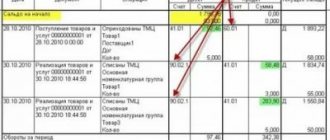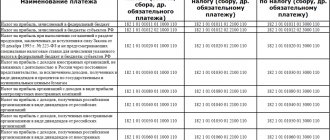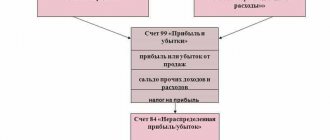In what cases is count 67 applied?
The account “Settlements for long-term loans and borrowings” is maintained by the organization receiving the credit (loan). In some cases, an enterprise needs to make expensive acquisitions, for example, equipment, but there is no free working capital at the moment. In such cases, it makes sense to take a long-term loan - that is, with a repayment period exceeding one tax period.
The account reflects information about counterparties (creditors) and loan agreements.
After the loan repayment period is reduced to 365 days, it can be transferred from 67 to 66 account “Short-term loans and borrowings”, or left on account 67. The chosen accounting method is fixed in the accounting policy of the organization.
Typical correspondence
Transferring a liability to a short-term liability
| Dt | CT | Operation description | Sum | Document |
| 67 | 66 | The amount was transferred to short-term | 680000 | Accounting information |
What it is
Settlements with suppliers of goods or raw materials, customers of these goods or personnel are one of the most important transactions in the life of every legal entity. 51 accounts in the accounting department is the “Settlement Accounts” register, designed to collect information about the availability of material assets in the national currency of the Russian Federation (in Russian rubles) and about their movement through the payment accounts of an organization or enterprise. Accounts, in turn, must be opened in financial and credit institutions. Register 51 is active, since the opening and closing balances for it can only be debit
Position 51 reflects the movement of all funds in current accounts
Getting a loan
Example
The organization Quadrum LLC received a loan from the bank in the amount of 1,578,000 rubles for a period of 3 years. Principal and interest are paid monthly in equal amounts.
Postings
| Dt | CT | Operation description | Sum | Document |
| 67 | Credit transferred to the organization's account | 1578000 | Bank statement | |
| 91.2 | 67 | Monthly interest accrued (payable) | 15122,50 | Accounting information |
| 67 | Monthly debt payment | 43833,33 | Payment order | |
| 67 | Monthly interest on loan | 15122,50 | Payment order |
What is it used for?
Account 51 was created in order to keep records, control and analyze data on the material funds of a legal entity that are located in banking organizations. This register reflects only payment and acceptance in the national currency of Russia.
Cash received by 51 registers will be accounted for as a Debit, and the amounts of all write-offs will be recorded as a Credit, which is obvious. One of the grounds for displaying receipts from this account is bank statements, and the amounts of all money transfers are carried out on the basis of instructions to make a payment.
Important! Analytical accounting for 51 accounts is carried out in the context of individual suppliers and customers who perform payment and receipt transactions with the company, as well as in the context of types of operations, for example, settlements with counterparties, payment of wages to personnel or payment of debt.
It is better to carry out analytics by dividing into counterparties and types of operations
Obtaining a loan by issuing bonds
The bond determines the right of its owner to receive from the issuer (the one who issued this security) its nominal value within a specified period, as well as, in some cases, a fixed percentage of the nominal value or other property rights.
Expenses for the issue (issue) of bonds are included by the organization in non-operating expenses.
Bonds can be placed at par value, above par value or below par value. In the first case, accounting is carried out only on account 67, in the second case, the difference is taken into account on account 98 “Deferred income”. In the second case, the difference is reflected by entries Dt 91.2 - Kt 67 evenly over the write-off period.
Example of placement above par
Mercury LLC placed a bond on the secondary market worth 15,000 rubles, with a par value of 10,000 rubles. The repayment period is 24 months.
Postings
| Dt | CT | Operation description | Sum | Document |
| 67 | The amount of the bond's par value is reflected | 10000 | Bank statement | |
| 98 | DS received above the nominal value are reflected | 5000 | Bank statement | |
| 98 | 91.1 | Monthly: 5000/24 | 208,33 | Accounting information |
Below par placement example
Saturn LLC placed bonds at a price of 8,000 rubles with a par value of 10,000 rubles. The repayment period is 18 months.
Postings
| Dt | CT | Operation description | Sum | Document |
| 67 | Reflects the amount of funds received from the placement of bonds | 8000 | Bank statement | |
| 91.2 | 67 | Monthly: 2000/18 - price deviation from nominal | 111, | Accounting information |
***
Accounting for long-term (more than 12 months) loans, credits, bills, issues of bonds and other securities must be kept separately from short-term (less than 12 months). This is required by PBU 4/99 “Accounting statements of an organization.”
To reflect long-term borrowed funds, account 67 is used, to which the organization opens the necessary sub-accounts for separate accounting of individual loans, credits, securities and their specification by creditors, banks, currencies and other characteristics.
Account 67 is passive. The credit balance at the end of the period is reflected in line 1410 “Borrowed funds” of section IV “Long-term liabilities” in the balance sheet. It is better to reflect accrued interest on lines 1450 in the “Long-term liabilities” section and 1520 in the “Short-term liabilities” section.
Work 67 positions in accounting
Any company at some point comes to the point that it needs additional resources when it comes to the need, for example, to update production equipment or implement some large project. Then long-term loans and borrowings from national or international financial and credit institutions are attracted.
Before we talk about accounting records, it should be said that according to current regulatory documents, there are two ways to legitimately formalize transactions for borrowed resources received. In this case, we can talk about a credit agreement or a loan agreement. Such a transaction involves a lender and a borrower. In accordance with the terms of the concluded transaction, the lender or creditor transfers to the borrower a certain amount of financial resources for an agreed period. After the specified period is completed, the borrower must return the received resources and pay interest on their use.
Companies can also obtain a long-term loan by placing bonds. In this situation, subaccount 67.6 is used. These bonds can be sold at a price either less or more than their face value.
If securities are sold at a discount, then during the entire period of their placement the accounting department writes off losses from other income. In this situation, the company's interest paid on the bonds is recorded in a separate sub-account. These amounts are part of the operating expenses incurred.
If we talk about account 67, then it summarizes data on long-term loans and credits attracted by the company. Borrowed funds received and interest accrued on them are reflected on the credit side of the designated position. The debit part shows the repaid obligations. Thus, the nature of this position is passive.
Analytics on it is carried out by types of funds raised and creditors.
Specifics of application of account 52 “Currency accounts”
Account 52 - Currency accounts The chart of accounts (approved by order of the Ministry of Finance of the Russian Federation dated October 31, 2000 No. 94n) is intended to reflect accounting transactions with non-cash foreign currency funds.
Read about the Chart of Accounts in the article.
Current accounts on which such transactions are carried out can be opened in both Russian and foreign banks. This circumstance determines the allocation of two sub-accounts on account 52, intended for accounting for funds in banks:
- Russian - subaccount 52-1;
- foreign - subaccount 52-2.
The Guide to ConsultantPlus describes in detail the specifics of accounting for foreign currency transactions. If you do not have access to the K+ system, get a trial online access for free.
Just as for ruble accounts, for foreign currency accounts reflected in accounting account 52, the following are required:
- organization of separate analytics not only for banks, but also for each account opened in this bank;
- using bank statements and payment documents attached to them as a basis for carrying out an operation.
Features of accounting on account 52 are due to the fact that:
- a foreign currency account opened in a Russian bank is actually represented by two accounts: transit (in which the funds are kept until the recipient submits documents identifying the payment to the credit institution) and current;
- According to accounting rules, accounting transactions must be reflected in ruble equivalent, and this requires: keeping records in parallel in two currencies (foreign and rubles);
- mandatory recalculation of currency balances on the date of the transaction and on the reporting date;
At the same time, you should remember that there is a ban (clause 1 of Article 9 of the Law “On Currency Regulation...” dated December 10, 2003 No. 173-FZ) on carrying out currency transactions between residents of the Russian Federation (with some exceptions). However, this does not mean that account 52 will show only settlements with non-residents and the results of recalculation of the ruble equivalent of foreign currency amounts.
Read about the rules that govern currency transactions in the Russian Federation in the publication “Currency transactions: concept, types, classifications.”
Accounting entries
The main item of transactions that can be carried out under 51 items are settlements with counterparties, who are suppliers of goods or raw materials, customers when performing services, and buyers. All these actions are carried out in accordance with previously concluded agreements. Typical transactions for such operations are as follows:
- Debit 51 Credit 62 - Receipt of funds from customers for goods or services (both as an advance payment and as a full final payment);
- Debit 51 Credit 60 - Returns by suppliers of goods or services before they are paid for;
- Debit 51 Credit 43 - Receipt of money for the provision of goods transportation services;
- Debit 51 Credit 76 - Receipt of money under concluded agreements with counterparties;
- Debit 60 Credit 51 - Payment to suppliers or contractors for services, goods or work rendered, both in the form of an advance payment and in the form of final payment;
- Debit 62 Credit 51 - Return to customers or buyers of funds that were credited by mistake earlier;
- Debit 76 Credit 51 - Accrual of money to other organizations and persons for other types of transactions;
- Debit 51 Credit 90 - Receiving revenue from the sale of products or performance of work (rendering services);
- Debit 51 Credit 91 - Receiving income from sales and other disposals, as well as reflecting non-operating income.
Important! Account assignments about changes in the state of accounted objects, described above, are not comprehensive for 51 registers, since it corresponds with a large number of positions, both for Debit and Credit. More wiring can be done.
Form of the Turnover balance sheet for 51 registers
Types of loans and borrowings
Account 67 contains information about different types of borrowed funds. The only thing they have in common is the commitment period, which is at least 12 months from the reporting date. Loans can be in the form of earmarked funds, promissory notes or bonds. The main difference between this method of attracting assets is that a bank cannot act as a lender. A loan is a legally formalized transaction, according to which the parties agree to transfer funds or property into ownership on the terms of return with or without payment of interest for use. Individuals and legal entities can enter into such an agreement, with the exception, as already mentioned, of banks. One of the ways to attract loans is to issue securities (bills, bonds, shares).
A loan is a relationship between parties in which funds are transferred on loan on the terms of urgency, payment and repayment. The procedure for granting and repaying loans is regulated by law. The rights and obligations of the parties are specified in the loan agreement. Account 67 contains information about long-term loans and interest on them.
Results
On account 52, accounting of foreign currency funds available in accounts in Russian and foreign banks is carried out. In comparison with ruble accounts, currency accounting has a number of features due to:
- rules for opening an account;
- mandatory parallel reflection of currency amounts in rubles;
- the ability to buy and sell currency.
At the same time, for foreign currency accounts it is possible to use the same set of account correspondence as for settlements in rubles.
These possibilities will be limited by a ban on currency payments between residents. You can find more complete information on the topic in ConsultantPlus. Free trial access to the system for 2 days.
Accounting for bills received from the buyer:
If the buyer issued a promissory note to the seller, it must be accounted for in subaccount 3 “Bill of note received” of account 62. After the sale of the product, posting D51 K62. Bill of exchange received - this bill is repaid.
If the nominal value of a bill of exchange received exceeds the sale price, then the excess amount is reflected in entry D62. Bill of exchange received K 90/1.
Postings to account 62 when paying by bill of exchange:
| Debit | Credit | Operation name |
| 62 | 90/1 | Revenue from the sale of goods is reflected. Accounting for a bill received from the buyer. |
| 62.Bill received | 62/1 | The bill received from the buyer was taken into account |
| 51 | 62.Bill received | The received bill is repaid |
| 62.Bill received | 90/1 | The excess of the nominal value of the bill over the sale price is reflected |
Existing subaccounts
There are no official sub-accounts for 51 items. In accounting software like 1C: Enterprise or 1C: Accounting, you can create your own sub-accounts and even accounts. This is often used, but mistakes also happen often. By adding 51.01, 51.02 and other subaccounts, you can find that the ending balance for Debit and Credit will be the same at the end of one month, and then will be different.
Many people are accustomed to adding subaccounts to simplify work or to separate costs and profits for different types of activities. In new versions of 1C: Accounting 8, adding subaccounts may not end in the best way.
Important! Problems especially often appear at the end of the month, when it needs to be closed. The amounts in the subaccounts simply freeze, which requires additional modifications and procedures for closing the month.
The desire to add your own subaccounts and accounts in new versions of 1C may end badly
Types of borrowed funds
The legislation provides for two methods of legal registration of provided borrowed funds. This is a credit agreement and a loan agreement. When concluding them, two parties are involved - the lender and the borrower. A legally fixed transaction is made, according to which the lender provides the borrower with a certain amount of material assets for a specified period. Upon its expiration, the borrower undertakes to return the original amount of funds provided and pay interest (if provided for in the agreement). After the transfer of valuables from the lender to the borrower, the agreement is considered active.
Depending on the terms of the agreement and the categories of persons who take part in it, there are two main types of borrowed funds: credits and borrowings. Taken together, they form one of the most important elements in the formation of enterprise sources. Borrowed funds, along with own funds, significantly influence the well-being and development of the economic activity of a legal entity.
Accounting information about the account
The reference document on the balances and turnover of account 67 is the account balance sheet for the period. It will show the total total amounts of receipts and payments of loans and borrowings for the period, as well as account balances.
Analytical accounting data for account 67 can be seen in the balance sheets broken down by subaccounts.
And more detailed information on all operations of the period is provided by the statement of account transactions. If information is needed on a specific organization or agreement, then a statement of transactions for the counterparty or agreement is generated.








